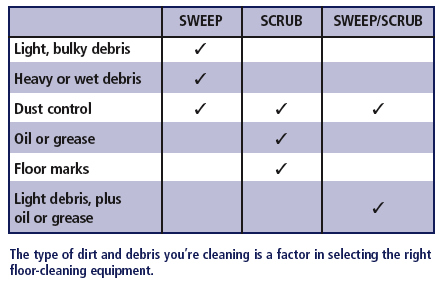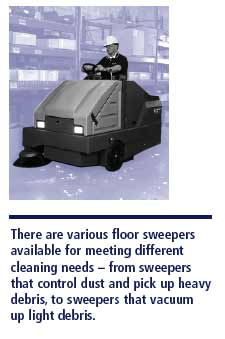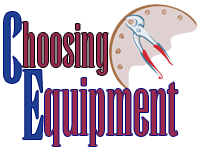Sweep or Scrub Basics
How to Determine Which
Floor-cleaning Approach Fits Your Application
by Dave Ditty, Training Manager
Advance Sweepers
There are numerous reasons for sweeping or scrubbing floors in a plant or warehouse - increased productivity, worker safety, product contamination,
protecting the floor surface and maintaining a quality image. On average, a
manufacturing plant spends 931,850 hours per year maintaining floor surfaces -
551,984 of those hours are spent sweeping and 379,554 hours are spent
scrubbing, with the remaining hours spent polishing or resurfacing. When you
consider costs to clean, a manufacturing facility spends, on average, $2.15 annually
per square foot on maintenance - with labor accounting for over 90% of total
floor-cleaning costs. That's why it's essential to find a floor-cleaning approach that
not only meets your facility's cleaning requirements but also helps increase your
productivity - both in time and labor. However, determining whether to sweep,
scrub or both - and what type of equipment to use based on your cleaning needs
is not the straightforward decision it might seem.
SWEEP OR SCRUB?
Here are some initial factors to consider when determining whether sweeping,
scrubbing or a combination of both is best for your plant or warehouse.
- The size of dirt and debris particles generated
- The amount of dirt and debris generated
- The character of the dirt (fibrous, oily, dusty, wet)
- The type of floor surface (tile, bare concrete, coated concrete, outdoor, etc.)
- A definition of what constitutes “clean” for your facility
 'Clean' can mean anything from getting rid of chunks of dirt on the floor
to creating a shiny, scuff-free surface. Your facility's cleanliness goal will be a factor
in your equipment choice. For example, if “clean” means getting rid of forklift tire
marks and other stains in addition to dust and debris, then your cleaning process
will have to include scrubbing as well as sweeping.
After you assess the size and amount of dirt and debris
to be removed, your primary decision is 'sweep or
scrub.'
'Clean' can mean anything from getting rid of chunks of dirt on the floor
to creating a shiny, scuff-free surface. Your facility's cleanliness goal will be a factor
in your equipment choice. For example, if “clean” means getting rid of forklift tire
marks and other stains in addition to dust and debris, then your cleaning process
will have to include scrubbing as well as sweeping.
After you assess the size and amount of dirt and debris
to be removed, your primary decision is 'sweep or
scrub.'
This decision is not always straightforward. For
example, if the material to be cleaned is mostly fine
dust, it would seem that a sweeper would be the ideal
tool to remove it. But the best way to handle dust is to
'add water,' which in turn eliminates your dust
problem; this means a scrubber may actually be the
better equipment choice.
FLOOR SWEEPERS 101
There are two types of sweepers: vacuum and broom. The type of sweeper you
select depends on the type of debris in your facility.
Vacuum sweeper - This type of sweeper is ideal for picking up light, bulky debris
such as leaves, paper cups or newspapers, and the shredded paper and packing
materials found in shipping areas. Vacuum sweepers rely entirely on vacuum
suction to pick up debris from surfaces and deposit it into large bags or dirt bins.
Vacuum sweepers do an exceptional job of mulching and digesting large quantities
with ease and efficiency. However, they are not efficient in picking up heavy, dense
debris or any material that is matted to the ground. The majority of vacuum
sweepers are walk-behind models.
Broom sweeper - This type of sweeper is ideal for applications where heavier
debris and dust control are critical factors, such as food handling and processing
facilities or electronics manufacturing. They are designed to pick up heavier, more
dense debris, particularly when it's packed down and adhered to the floor surface.
Most broom-type sweepers have vacuum and filter systems to control dust while
sweeping, making them ideal for dusty jobs. However, this vacuum and filter
system is not the same system used in vacuum sweepers; it is not designed to
vacuum up debris.
Another factor when evaluating power sweepers is the type of sweeping system
that the machine uses. There are three types of sweeping systems - dustpan,
overthrow and dust control.
Dustpan principle - In the dustpan sweeping system, the main broom sweeps
debris straightforward into a hopper in the front of the machine. This allows the
hopper to be removed from the machine and debris to be dumped directly into a
trash receptacle. Most walk-behind sweepers utilize the dustpan system.
 Overthrow principle - Most large rider sweepers utilize 'top-loading' or
'over-the-top' sweeping systems. This type of sweeping system is ideal for
sweeping and loading light, bulky debris. Debris is dropped into a rear loading
hopper more easily than it is thrown into a dustpan. Top-loading sweeping systems
utilize four-sided hoppers, which load more easily and allow larger debris loads to
be swept and transported. Unlike the dustpan system which only fills to 60% of
hopper capacity, top-loading systems fill to 100% of capacity.
Overthrow principle - Most large rider sweepers utilize 'top-loading' or
'over-the-top' sweeping systems. This type of sweeping system is ideal for
sweeping and loading light, bulky debris. Debris is dropped into a rear loading
hopper more easily than it is thrown into a dustpan. Top-loading sweeping systems
utilize four-sided hoppers, which load more easily and allow larger debris loads to
be swept and transported. Unlike the dustpan system which only fills to 60% of
hopper capacity, top-loading systems fill to 100% of capacity.
Dust control - The degree to which dust interferes with production and the quality
of finished goods varies from one application to another. Electronics manufacturers,
for example, require dust-free environments because electronic components are
extremely sensitive to dust and dirt. The latest refinement in dust filtration is the
pleated paper-type filter cartridge. These filter cartridges extend the time between
filter cleaning by as much as 40%. This type of filtration system, combined with a
vacuum fan adequate to move the necessary air volume, provides the best filtration
for controlling dust.
HOW TO SELECT THE SIZE AND MODE OF SWEEPER
Once you have matched the general type of debris in your facility to the type
of sweeper to handle the job, your next step is to determine the size and mode of
equipment you need - the sweep path width and whether you need a walk-behind
or ride-on machine. Size and mode are determined by looking at the size of your
main aisles, total square footage, frequency of sweeping, traffic and quantity of
debris.
As a rule of thumb, if your aisles are eight feet wide or over and you have
100,000 square feet or more of sweeping, a rider sweeper will be most efficient
and operator friendly. Smaller rider sweepers or walk-behinds are recommended
for smaller areas and narrower aisles. Many facilities have both types of sweeping
areas and use more than one sweeper, to fit specific areas' needs.
AUTOMATIC SCRUBBERS 101
From walk-behind scrubbers that replace mop-and-bucket cleaning to high productivity
ride-on scrubbers, automatic scrubbers are designed to leave
hard floor surfaces clean, dry and ready for foot or machine traffic. An automatic
scrubber used on a daily or weekly basis will maintain the floor surface and
prevent the buildup of oil, grease and other stains. It will also improve the
appearance of the floors, removing forklift tire marks and make floors safer for
people and machines.
MATCHING THE RIGHT SCRUBBER BRUSH TO YOUR APPLICATION
The basic function of an automatic scrubber is to lay down a cleaning solution,
agitate the solution with scrub brushes and recover the dirty solution with a
squeegee. However, just as with sweepers, there are design and construction
differences between various styles of scrubbers.
There are basically two scrub brush principles in operation today – disc and
cylindrical. Some manufacturers offer scrubbers with both disc and cylindrical
scrub decks that can be easily switched without tools.
Disc brushes for aggressive cleaning of smooth surfaces - These flat circular disctype
scrub brushes are intended for applications that require tough cleaning. Disc
brushes follow dips and low spots in floors to provide a constant downward
pressure – delivering more aggressive scrubbing. Disc brushes also allow you to
use less cleaning solution. However, depending on the area to be cleaned,
sweeping may be required first.
Cylindrical brushes for rough, grouted floors - These circular brushes are ideal for
picking up light debris on rough, grouted surfaces – eliminating the need to presweep
prior to scrubbing. However, due to their length and design, cylindrical
brushes do not follow contours and dips in the floor.
SWEEPER-SCRUBBER COMBO MACHINES
If your facility requires both sweeping and scrubbing, there can be benefits to
purchasing a dual-purpose sweeper-scrubber. The initial purchase cost of a
sweeper-scrubber is less than purchasing each machine separately – and you only
own one machine instead of two.
In smaller facilities where one person is
performing floor-cleaning tasks, a sweeper-scrubber maximizes machine-in-use
time - with two machines, one of them would always be sitting idle. There is also a
labor savings factor with sweeper-scrubbers. Using a combination machine can
reduce your maintenance costs by as much as 50% because both sweeping and
scrubbing functions are handled by one machine and one operator.
HOW TO SELECT THE PROPER SIZE OF SCRUBBER
As with sweepers, determining the size of scrubber you need depends on the size
of main aisles, total square footage and the sizes of any auxiliary areas to be
cleaned (shipping docks, stock bins, etc.). Automatic scrubbers are designed to
clean large open areas where they can operate at their highest efficiency. Again,
like sweepers, more than one size scrubber may be needed depending on the
various areas to be cleaned.
EXAMINING YOUR FLOOR MAINTENANCE NEEDS
Most cleaning-industry experts recommend that facility and maintenance
managers work with a floor-cleaning professional, such as an equipment dealer,
who can analyze your needs and then recommend the most productive and costeffective
solutions.
An experienced equipment dealer will begin by assessing your current cleaning
program in terms of total square footage, surface types, time currently required to
clean specific areas, number and width of aisles and doorways and the number of
personnel involved in cleaning activities. Next, he should conduct a 'productivity
analysis' for you, weighing detailed information about your current cleaning
system with facts on the performance of new equipment alternatives. Your outside
consultant's goal should be to recommend the most productive equipment solution
– that makes sense financially - for each of your different cleaning needs.
CONCLUSION
In order to help ensure that a machine is the right match for your facility, many
equipment dealers will offer in-plant trials of equipment and provide training. These
in-plant trials will help you determine if your needs are best met by a sweeper,
scrubber or combination machine. Whether your plant requires sweeping, scrubbing
or both, you'll want to select floor-cleaning equipment that delivers the highest
cleaning productivity, as well as the best cleaning performance for your requirements.
 Advance produces a variety of floor cleaning equipment. For more information, go to www.advance-us.com. To reach the company by phone, in the U.S. call 800-214-7700; the toll free number in Canada is 800-668-8400.
Advance produces a variety of floor cleaning equipment. For more information, go to www.advance-us.com. To reach the company by phone, in the U.S. call 800-214-7700; the toll free number in Canada is 800-668-8400.
|

